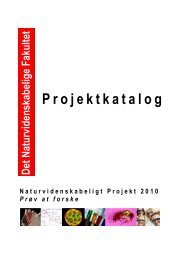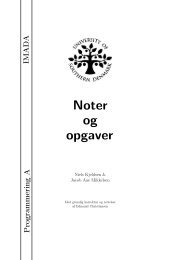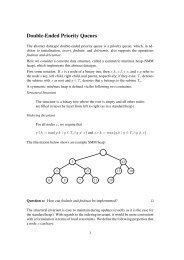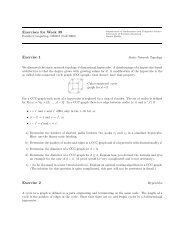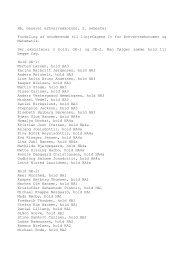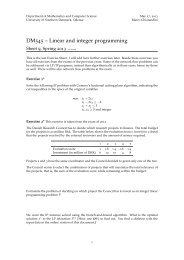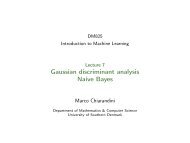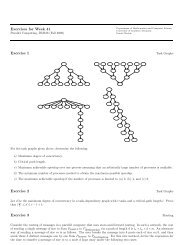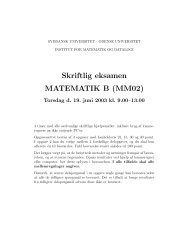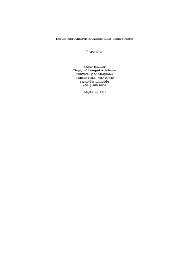Projekt 4. - Institut for Matematik og Datalogi - Syddansk Universitet
Projekt 4. - Institut for Matematik og Datalogi - Syddansk Universitet
Projekt 4. - Institut for Matematik og Datalogi - Syddansk Universitet
You also want an ePaper? Increase the reach of your titles
YUMPU automatically turns print PDFs into web optimized ePapers that Google loves.
N a t u r v i d e n s k a b e l i g t P r o j e k t / F a r m a c e u t : V a l g f r i t P r o j e k t<br />
<strong>Projekt</strong> 58. Simulation with Cellular Automata<br />
Vejleder: Daniel Merkle, daniel@imada.sdu.dk<br />
<strong>Institut</strong>: <strong>Institut</strong> <strong>for</strong> <strong>Matematik</strong> <strong>og</strong> Datal<strong>og</strong>i (IMADA)<br />
Praktisk del: Pr<strong>og</strong>rammering<br />
Gruppeplacering: Biblioteket<br />
Gruppestørrelse: Mindst 3 <strong>og</strong> max 5 deltagere. Én gruppe kan arbejde med projektet.<br />
Kommentarer: <strong>Projekt</strong>et er sœrligt velegnet til studieordning i datal<strong>og</strong>i / The project is specially<br />
suitable <strong>for</strong> students with curriculum in computer science<br />
Keywords:<br />
Computer Science, Cellular Automata, Modeling and Simulation, Pattern<br />
Formation<br />
Abstract<br />
In 1952 the English mathematician, l<strong>og</strong>ician,<br />
and computer scientist Alan Turing stated: “It<br />
is suggested that a system of chemical substances,<br />
called morph<strong>og</strong>ens, reacting t<strong>og</strong>ether<br />
and diffusing through a tissue, is adequate to<br />
account <strong>for</strong> the main phenomena of morph<strong>og</strong>enesis.''<br />
With relatively easy mathematical<br />
<strong>for</strong>mulations and by means of simulations<br />
with so-called cellular automata (CA), it is<br />
possible to model and analyze the related problem of pattern <strong>for</strong>mation that occurs on sea shells<br />
or on animal skins. A CA is a remarkable simple discrete model studied in computability theory<br />
that consists of a regular grid of cells each in one of a finite number of states, such as “On” and<br />
“Off”. Each cell has a finite set of neighborhood cells. The current state of a cell itself and the<br />
current states of the cells in its neighborhood are considered to determine synchronously the new<br />
state of a cell.<br />
In a straight<strong>for</strong>ward manner such CA can be used to simulate the mechanism that is supposed to<br />
be responsible <strong>for</strong> generating the be<strong>for</strong>e mentioned patterns. This mechanism is based on a socalled<br />
reaction-diffusion system of the morph<strong>og</strong>en prepatterns. The subsequent differentiation of<br />
cells to produce melanin (pigments that affect skin color) simply reflects the spatial patterns of<br />
morph<strong>og</strong>en concentration.<br />
An introduction to cellular automata will be included. The project aims at giving the participants<br />
knowledge on modeling with CA and experience in the implementation of CA-based simulations<br />
(simulation of animal skin patterns is just one suggestion).<br />
Minikurser<br />
Obligatorisk: <strong>Projekt</strong>arbejde (LaTeX).<br />
Anbefalede: Ingen<br />
Litteraturliste over metode artikler, som udleveres til de studerende<br />
A. Deutsch, S. Dormann: Cellular Automaton Modeling of Biol<strong>og</strong>ical Pattern Formation,<br />
Birkhäuser Boston, 2005.<br />
L.B. Kier, P.G. Seybold, and C.-K. Cheng: Modeling Chemical Systems Using Cellular Automata,<br />
Springer Netherlands, pages 9-38, 2005.<br />
60




